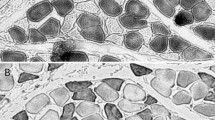Abstract
Purpose
The anterior and lateral cervical muscles (ALCM) are generally considered to be postural, yet few studies have investigated ALCM fiber types to help clarify the function of these muscles. This study aimed to systematically investigate ALCM fiber types in cadavers.
Methods
Anterior and lateral cervical muscles (four scalenus anterior, medius, posterior muscles; five longus colli, five longus capitis taken bilaterally from one cadaver) were removed from four male embalmed cadavers (mean age 87.25 years). Paraffin-embedded specimens were sectioned then stained immunohistochemically to identify type I and II skeletal muscle fibers. Proportional fiber type numbers and cross-sectional area (CSA) occupied by fiber types were determined using stereology (random systematic sampling). Results were analyzed using ANOVA (P < 0.05) and descriptive statistics.
Results
Scalenus anterior had the greatest average number and CSA of type I fibers (71.9 and 83.7 %, respectively); longus capitis had the lowest number (48.5 %) and CSA (61.4 %). All scalene muscles had significantly greater type I CSA than longus capitis and longus colli; scalenus anterior and medius had significantly greater type I numbers than longus capitis and longus colli. Some significant differences were observed between individual cadavers in longus colli for CSA, and longus capitis for number.
Conclusion
The ALCM do not share a common functional fiber type distribution, although similar fiber type distributions are shared by longus colli and longus capitis, and by the scalene muscles. Contrary to conventional descriptions, longus colli and longus capitis have type I fiber proportions indicative of postural as well as phasic muscle function.


Similar content being viewed by others
References
Benyamin R, Singh V, Parr AT, Conn A, Diwan S, Abdi S (2009) Systematic review of the effectiveness of cervical epidurals in the management of chronic neck pain. Pain Physician 12:137–157
Ylinen J, Takala E-P, Nykanen M, Hakkinen A, Malkia E, Pohjolainen T, Karppi S-L, Kautiainen H, Airaksinen O (2003) Active neck muscle training in the treatment of chronic neck pain in women. JAMA 289:2509–2516
Ylinen J (2007) Physical exercises and functional rehabilitation for the management of chronic neck pain. Eura Medicophys 43:119–132
O’Leary S, Falla D, Elliott JM, Jull G (2009) Muscle dysfunction in cervical spine pain: implications for assessment and management. J Orthop Sport Phys 39:324–333
Moore K, Dalley AF (2006) Clinically oriented anatomy, 5th edn. Lippincott Williams & Wilkins, Baltimore, p 1078
Standring S (Ed) (2008) Gray’s Anatomy. 40th Ed. Elsevier, Edinburgh, p 443
Boyd-Clark LC, Briggs CA, Galea MP (2002) Muscle spindle distribution, morphology, and density in longus colli and multifidus muscles of the cervical spine. Spine 27:694–701
Elliott JM, O’Leary S, Sterling M, Hendrikz J, Pedler A, Jull G (2010) Magnetic resonance imaging findings of fatty infiltrate in the cervical flexors in chronic whiplash. Spine 35:948–954
Flowers JM, Hicklin LA, Marion M-H (2011) Anterior and posterior sagittal shift in cervical dystonia: a clinical and electromyographic study, including a new EMG approach of the longus colli muscle. Movement Disord 26:2409–2414
Jull G, Barrett C, Ho P (1999) Further clinical clarification of the muscle dysfunction in cervical headache. Cephalalgia 19:179–185
Nitz JC, Burns YR, Jackson RV (1995) Development of a reliable test of (neck) muscle strength and range in myotonic dystrophy subjects. Physiother Theory Pract 11:239–244
Wolzak H, van de Rest M, Geurts M, ter Borg E-J (2010) Acute calcific tendinitis of the longus colli muscle. Clin Radiol 16:240
O’Leary S, Falla D, Jull G (2003) Recent advances in therapeutic exercise for the neck: implications for patients with head and neck pain. Aust Endod J 29:138–142
Falla D, O’Leary S, Farina D, Jull G (2011) Association between intensity of pain and impairment in onset and activation of the deep cervical flexors in patients with persistent neck pain. Clin J Pain 27:309–314
Falla D, O’Leary S, Fagan A, Jull G (2007) Recruitment of the deep cervical flexor muscles during a postural-correction exercise performed in sitting. Manual Ther 12:139–143
Sanders RJ, Ratzin-Jackson CG, Banchero N, Pearce WH (1990) Scalene muscle abnormalities in traumatic thoracic outlet syndrome. Am J Surg 159:231–236
Uhlig Y, Weber BR, Grob D, Muntener M (1995) Fiber composition and fiber transformations in neck muscles of patients with dysfunction of the cervical spine. J Orthopaed Res 13:240–249
Boyd-Clark LC, Briggs CA, Galea MP (2001) Comparative histochemical composition of muscle fibres in a pre- and a postvertebral muscle of the cervical spine. J Anat 199:709–716
Lexell J, Taylor C, Sjostrom M (1985) Analysis of sampling errors in biopsy techniques using data from whole muscle cross sections. J Appl Physiol 59:1228–1235
Sheard PW, Anderson RD (2011) Age-related loss of muscle fibres is highly variable amongst mouse skeletal muscles. Biogerontology 13:157–167
Johnson MA, Polgar J, Weightman D, Appleton D (1973) Data on the distribution of fibre types in thirty-six human muscles: an autopsy study. J Neurol Sci 18:111–129
Cornwall J, Stringer MD, Duxson M (2011) Functional morphology of the thoracolumbar transversospinal muscles. Spine 16:E1053–E1061
Mannion AF, Dumas GA, Cooper RG, Espinosa FJ, Faris MW, Stevenson JM (1997) Muscle fibre size and type distribution in thoracic and lumbar regions of erector spinae in healthy subjects without low back pain: normal values and sex differences. J Anat 190:503–513
Weber BR, Grob D, Dvorak J, Muntener M (1997) Posterior surgical approach to the lumbar spine and its effect on the multifidus muscle. Spine 22:1765–1772
Rantenen J, Rissanen A, Kalimo H (1994) Lumbar muscle fiber size and type distribution in normal subjects. Eur Spine J 3:331–335
Acknowledgments
The authors would like to thank Dr Tilman Davies, Statistician, for his helpful advice on the statistical analysis, and Mark D. Stringer, Honorary Professor of Anatomy, Otago School of Medical Sciences, Dunedin, for his involvement and encouragement in the early stages of this study.
Conflict of interest
The authors declare they have no conflict of interest.
Author information
Authors and Affiliations
Corresponding author
Rights and permissions
About this article
Cite this article
Cornwall, J., Kennedy, E. Fiber types of the anterior and lateral cervical muscles in elderly males. Eur Spine J 24, 1986–1991 (2015). https://doi.org/10.1007/s00586-015-3795-3
Received:
Revised:
Accepted:
Published:
Issue Date:
DOI: https://doi.org/10.1007/s00586-015-3795-3




